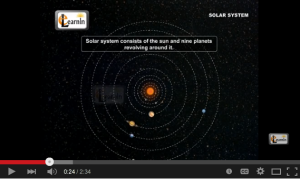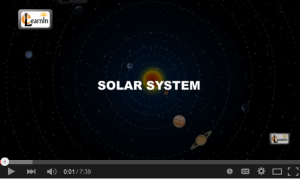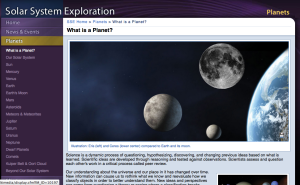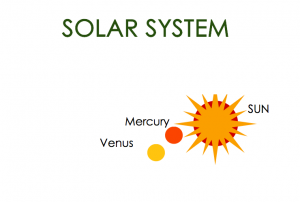Unit Objective
Learners will develop a graphic presentation of the Solar system with labels and side notes reflecting their thinking and understanding of the lesson.
Background and Rationale
Students will observe and investigate the nine different planets in books, documents, websites and videos. Learners will understand planet sizes, densities, characteristics, and distance from the sun. This lesson will take at least four to five 45-minute class periods to complete. The culminating activity requires students to create a technology-based presentation (graphic organizer) using glogster or piktochart in explaining their understanding of the Solar system.
The key concepts for the lesson:
- Number of planets explored and their names.
- Each planet has unique and identifiable characteristics.
- Have common characteristics
- Images of planets can be used to study their characteristics
How this lesson builds on and connects with previous lessons:
- They will recall what they see and observe everyday, for example, the Sun and Moon. Relate personal body mass with other objects. Night and day.
How you will build on this lesson in subsequent lessons.
Learners will relate what they learned from the lesson to the space and universe. They will develop an understanding why there are shooting stars and eclipses.
This lesson uses different methods of differentiation in order to meet different learning needs of the learners. for example:
- collaboration, group work;
- Powerpoint or Google Slides presentation that will have notes and pictures, graphics;
- Practice, homework Questions, cues ;
- Technology to create a visual presentation to reinforce understanding.
Lesson Objectives
Objective |
Bloom’s Verb |
|---|---|
| Given paper and pencil learners will list the names of the planets in relation to the sun with 100% accuracy. | List |
| Given powerpoint as a presentation tool learners will develop a list of classification pattern on the characteristics of the individual solar planets. | Develop |
| Compare the relationship of the nine planets in our solar system to the sun by creating a two-dimensional visual representation of the solar system. | Compare, Create |
Bloom’s Taxonomy
Creating (highest level)
Common Core / State and District Standards
- Reading Standards for Literacy in Science 6-8:RS.1 Cite specific textual evidence to support analysis of science texts.
- 6-8.RS.4 Determine the meaning of symbols, key terms, and other domain-specific words and phrases as they are used in a specific scientific context relevant to grades 6-8 texts and topics.
- 6-8.RS.7 Integrate quantitative information expressed in words in a text with a version of that information expressed visually (e.g., in a flowchart, diagram, model, graph, or table).
Technology Integration (ISTE) Standards
- 2.a. Interact, collaborate, and publish with peers, experts, or others employing a variety of digital
- 4.b. Plan and manage activities to develop a solution or complete a project
Lesson – Introduction
The lesson will begin with each student mentioning what their favorite planet is and stating why.
Lesson Activities and Procedures
Student Procedure |
Teacher Procedure |
Materials |
|---|---|---|
| After learners complete mentioning their favorite planets, the teacher will ask key question like: What are the visible characteristics of the planets and moons in our solar system? In what ways have researchers recorded observations of moons and planets, and what trends or patterns have been discovered? (15 Min) | The teacher will show a short video for 2.5 min | |
| Learners are grouped in 2-3 and are asked the following question which they take notes What is unique about each planet? Which planet do I like most and why If I could visit another planet which planet will it be and why? (15min) | The teacher will show another short video for 8 min | |
| A worksheet will then be provided to each learner and they will fill it out. This will be used to test their knowledge of the planets names, and the planets distance from the sun. (20 min). See worksheet below. | The teacher will ask students to share their thinking with the class and note commonalities and differences amongst the responses of their peers. The teacher will also lead a discussion on how the responses connect to or shift from the initial responses. | worksheet |
| After the lecture, learners will be grouped in 3-4 and they will share their ideas and understanding with each other. They will then be allowed to use the computer to prepare a Powerpoint presentation. (20 min) | The Teacher will provide the learners and graphical illustration with a lecture and explain the characteristics of each planet and their sizes and distance in relation to the Sun. (20 min). | illustration, Powerpoint |
| Students will go home and research more on the planets such as when each planet was discovered, their sizes, chemical compositions. They will create a graphical presentation of the solar system using Piktochart with notes and sketches making their thinking visible. | The teacher will provide a link for a website to research (2 min). |
Lesson – Closure
At the end of the lesson each student will say what he/she is “taking home” from the lesson and the teacher will make a list of them to recall for the next lesson.






